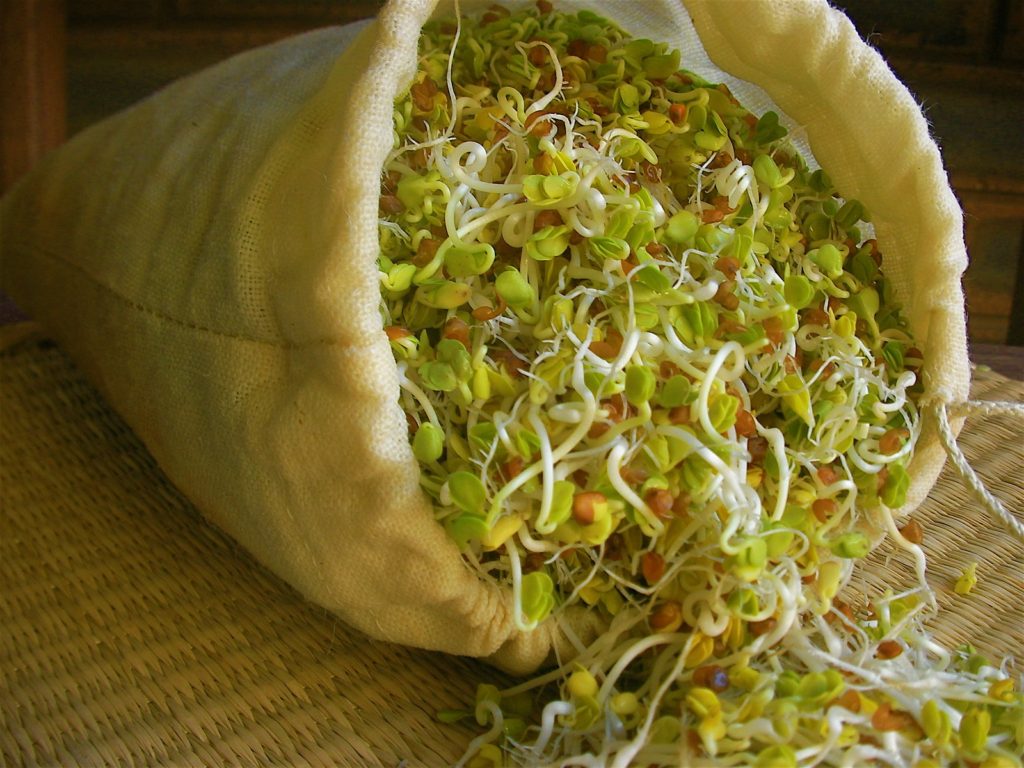The following is an excerpt from Wild Flavors: One Chef’s Transformative Year Cooking from Eva’s Farm by Didi Emmons. It has been adapted for the Web.
Growing sprouts is one of the simplest things you can do to breathe life into the deprivations of winter. As an urbanite who doesn’t have much space or sun to grow food, sprouts are one thing I can grow at any point in the year. Sprouts are replete with vitamins, minerals, proteins, and enzymes. Sprouting is easy, as easy a process as cooking rice. And there is a satisfaction in fostering and watching them grow and prosper. It feeds my maternal side, without the crying and diapers.
Most any edible seed can become an edible sprout, but I like to sprout wheat berries, kamut, quinoa, lentils, and chickpeas. Other possibilities include hulled sunflower seeds, buckwheat groats, spelt, soybeans, peas, brown mustard seeds, radish seeds, broccoli seeds, rye seeds, cabbage seeds, and herb seeds. You can also sprout raw peanuts, black-eyed peas, adzuki beans, green channa, and, more commonly, alfalfa, clover, and mung bean. Tomato and potato sprouts are said to be poisonous.
Growing Sprouts: The Eva Way
There are two main ways to grow sprouts at home: in a jar or in a bag (of any sturdy mesh fabric, whether natural or synthetic fiber).
- In either case, start by rinsing about 1 cup of legumes or seeds and then letting them soak overnight.
- Drain, rinse again, and transfer the legumes or seeds to a big glass jar or mesh bag large enough to hold five times the quantity of seeds or legumes that you have.
- Tie the bag closed or secure cheesecloth over the mouth of the jar to keep debris out and to facilitate easy straining. Hang the bag or store the jar in a dark, humid place if possible, and rinse morning and night.
- Eventually, after somewhere between two and ten days, depending on the type of seed, you will notice that the seeds have sprouted.
You may have noticed that there is a lot of rinsing involved here, and watching all of that barely used water head down the drain goes against every fiber in Eva’s body. When she rinses the seeds or legumes the first time, she catches that liquid in a bowl. To rinse the seeds or legumes afterward, she simply dips her bag into the captured water, lifts it up, and shakes the liquid out. Once the seeds or legumes have sprouted and the rinsing has ended, she uses the liquid for a variety of creative uses, from cooking her morning cereal to watering (and nourishing) plants.
Sources
Don’t buy your seeds at a garden center, there is a risk they may be contaminated with chemicals or bacteria. I get my seeds at a local natural foods store and they sprout—no problem. But if you are serious, there are plenty of websites like Sproutman.com that sell seed grown specifically for human consumption. “The Sproutman” also offers a helpful circular sprout chart for $5 that lists an array of seeds you can sprout, with the corresponding sprouting times, the suggested method, the level of difficulty, uses, flavors, and so on. It is worth getting.
Storage
After giving sprouts one final rinse, put them back in the same container you grew them in or in a plastic bag poked with a knife to ensure air circulation. Sprouts are living plants. They last about a week in the fridge in a plastic container, though legume sprouts may last longer.
What to do with all your new sprouts? Wild Flavors, has a tasty (and easy) hummus recipe using sprouted chickpeas:
Sprouted Hummus From Wild Flavors by Chelsea Green Publishing


My daughter has been wanting to grow plants, but we really don’t have much room. I never though about trying to grow sprouts, though. What a great idea! Thanks for the inspiration.
I have never heard of this. I will have to give it a try- sounds like a very healthy inexpensive food option!
I like to pretend that I have a green thumb until I see the one and only plant in my house starting to droop from lack of water.
Ooops!
I totally can grow a garden outside but something happens when the plants live inside.
Just don’t get it!
I love eating sprouts but never though of growing my own….
Oh wow, I had no idea it was so easy! I don’t eat a lot of bean sprouts myself, but I have a few friends that do, so I will pass this on!
I love sprouts in my salads and on sandwiches too! I will be giving this a try to grow my own!
I love the bean sprouts in salads. Yet something else to put on my “I will do this in the future” list!
We used to do that one year in school. I still have my garden and had one almost every year since leaving home. No matter how small, you always ave enough space for herbs or as in this case sprouts.
I didn’t realize how easy it was to grow sprouts. I am going to pick up some supplies the next time I am at the health food store
That looks easy and fun. I love adding sprouts to salads and sandwiches.
That is so interesting! We grow tons of stuff in our gardens in the summer but it never occurred to me to grow sprouts! Thank you!
Great tips. I found this real interesting!
I have a friend who would really love this post. Sharing!
I had never thought about growing sprouts! What a great way to grow healthy and small!
I love sprouts but I’ve never thought about growing them! I’m definitely going to have to try this!
my hubby and 8 year old love brocco sprouts in sandwiches and on salads.
I have never grown sprouts – fun project! This is something my hubby would love to do…we are checking this out!
I’ll have to try this!
i heard sprouts are really good for you, I have sunflower seeds to sprout.
Thanks for the gardening education. This looks like something I could so do. We art trying to eat much healthier and that includes sprouts. I would love to be able to know they were grown organically.
Great article. We were just discussing sprouts last night. Maybe I will take out some legumes to start sprouting.